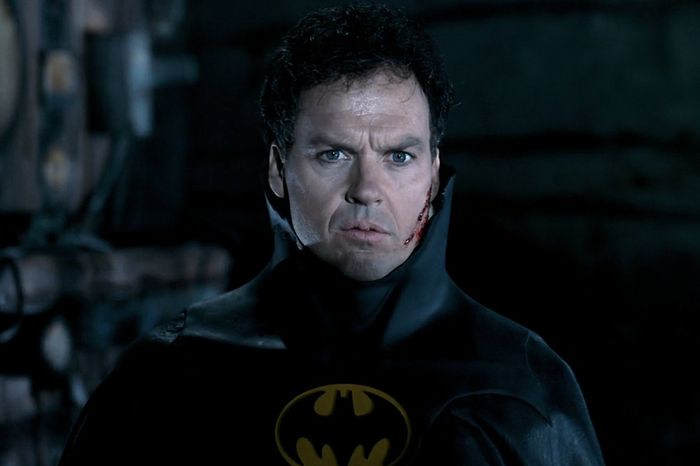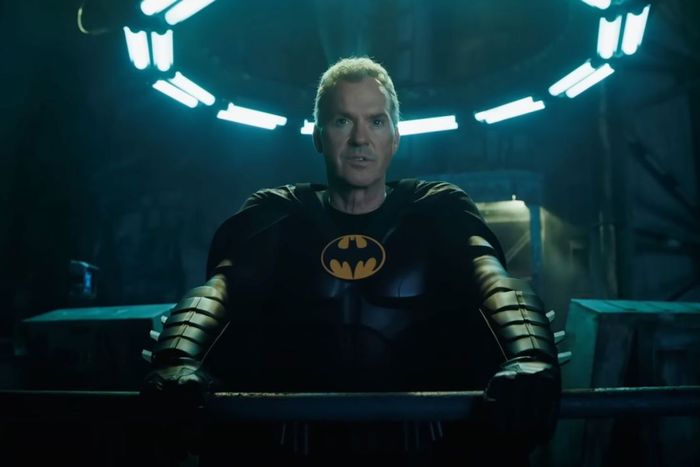
This piece was originally published in June. We are recirculating it now timed to The Flash’s streaming debut on HBO Max.
“I’m Batman,” Michael Keaton declares in that old dramatic whisper, and the crowd goes wild all over again. Thirty-one years after the star of Tim Burton’s Batman and Batman Returns hung up the cape and cowl, he has donned them anew for another DC superhero spectacular. Keaton’s caped crusader, brought out of retirement via the reliable sci-fi magic of time travel, plays a supporting role in The Flash. But that hasn’t stopped Warner Bros. from making him central to the marketing with the iconic Bat symbol looming large on the poster and the trailers dominated by glimpses of the actor in his old battle garb, ritualistically uttering dialogue from a bygone era of comic-book movies. The roars of applause that greeted these scenes during coming attractions and advance screenings made it clear: Audiences have been dying to see Keaton back in black.
That excitement must be vindicating, on some level, for the star. Because it wasn’t always this way. If you could go back in time, Barry Allen style, to the fall of 1988 — during the lead-up to Batman’s historic release — you’d see some starkly different reactions to the idea of Keaton, of all actors, under the mask of comicdom’s most beloved vigilante. Back then, “I’m Batman” wasn’t guaranteed to earn cheers. Judging from the general response to the casting, it might have easily provoked an annoyed retort: “No, you’re not!”
When the news broke in 1988 that Keaton had nabbed the lead role in Burton’s expensive, buzzed-about adaptation, fans weren’t just perplexed. They were outraged. This was before the internet gave every enthusiast an easy way to log their disdain at the click of a button. To make their disapproval heard, they had to put pen to paper. Warner Bros. is said to have received some 50,000 letters complaining about Keaton’s casting. Signed petitions also made the rounds. So vehement was this analog write-in crusade that major publications covered the backlash as breaking news, filling columns with incensed quotes from the everyday Bat aficionado. The Wall Street Journal even devoted its front page to the controversy.
Part of the skepticism stemmed from Keaton’s physical suitability for the suit, or lack thereof — the ways that he did not fit the typical profile of an action hero, even in his youth. He was five-foot-ten with a medium build and what comic-book writer Beau Smith described in that Journal story as a “receding hairline and a less-than-heroic chin.” A couple years earlier, Frank Miller had made Batman look like Clint Eastwood in his dazzling, dystopian graphic novel The Dark Knight Returns. Keaton, to put it mildly, struck a less imposing figure, especially compared to the more seemingly apropos stars, like Harrison Ford and Mel Gibson, who were both in consideration for the role before Burton and his producers settled on their unlikely leading man.
But it wasn’t just that Keaton didn’t look the part. His sensibility seemed, to the average fan, all wrong for the caped crusader. It was the actor’s dramatic departure in the same year’s addiction drama Clean and Sober that allegedly won him the role — and won over an in-house skeptic, producer Michael Uslan. But audiences at that point knew Keaton primarily for his work in comedies like Mr. Mom and Burton’s previous movie, Beetlejuice, in which the star played the title role of a prankster apparition much closer in anarchic spirit to Batman’s archnemesis, the Joker. How was this cutup going to convince as a creature of the night, striking fear in the heart of hoodlums?
Concealed behind these complaints, like a secret identity protected by a mask, was the real insecurity that Keaton’s casting stoked. Putting a comic actor in the dark rubber duds seemed to hint that Burton would be taking a derisively parodic approach to Batman, playing him for laughs. Keaton had to shoulder the legacy of a fanbase’s lingering resentment toward what was then the most popular of Batman adaptations, the eternally campy ’60s Adam West TV series that drained every drop of menace and danger from the mythos. Acclaimed ’80s story lines like Miller’s and the disturbing Alan Moore one-shot The Killing Joke had reclaimed the superhero’s gravity, rescuing him from the frivolity of his previous live-action iteration. The concern was that Burton planned to walk that image rehabilitation back.
Such worries would prove unwarranted. Burton may not have been much of a comic-book fan, traditionally speaking, but his vision for Batman was much closer in spirit to The Dark Knight Rises than it was to West’s divisive tenure in the tights. Perhaps that’s one reason fans came around to Keaton. Or maybe they just needed to actually see him in costume and in action. An early press still, showing off the cumbersome but cosmetically appealing Batsuit, is sometimes credited for turning the tide and assuaging some fears. So, too, is the film’s oddly music-free first teaser, a collection of shots and lines from the movie — including “I’m Batman” — that went a long way toward convincing people that Burton wasn’t going to reduce Batman to a “wham-pow” joke again, and that he had operatic aims.
The irony of fans changing their mind about Keaton is that he did, in a sense, end up bringing a comic element to Batman, or at least to his alter ego, the wealthy orphan with the secret nightlife, Bruce Wayne. The actor looks dashing enough in a tuxedo, wandering Wayne Manor during a charity gala. But from the moment Keaton opens his mouth, he’s doing a certain eccentric shtick, playing Wayne not as a suave playboy but a fidgety neurotic whose immense, sheltering privilege has left him a little socially inept. Keaton, in other words, makes Wayne a rather likable weirdo — one of Burton’s signature sympathetic misfits. “You’re not exactly normal, are you?” asks love interest Vicki Vale, which puts a fine point on it.
Batman and Burton’s weirder, nastier, superior sequel find light humor in a rich aristocrat trying to balance his life in the public eye with his crime-fighting duty. In the first film, we get amusing scenes like the first date between Wayne and Vale, sitting awkwardly down for dinner on opposite sides of a long table in a room he claims he’s never entered before. Later, Keaton stammers through his attempt to explain who he really is, silently mouthing that same classic line when Vicki’s back is turned — a classic bit of screwball. Returns sidelines Wayne more, cutting his screen time in favor of the flamboyant villains. At the same time, the sequel would allow Keaton more room to be amusingly flustered, navigating a classic rom-com subplot in which Wayne and Michelle Pfeiffer’s Selina Kyle, a.k.a. Catwoman, tiptoe into a fledgling courtship while trading blows on rooftops.
There’s even a slight comedic quality to Keaton’s Batman. As much as Burton succeeded in framing him like a real threat, an almost vampiric force of ungodly vengeance in striking silhouette, he also found the faint humor in the superhero’s taciturn nature — through droll stares, silent reaction shots, and Keaton’s impeccable deadpan timing, somehow only enhanced by the stiff costume the actor had to endure for days on end. He’s borderline Chaplin-esque at times, a straight man at others; there’s comic tension in the discrepancy between his poker-faced stoicism and the theatrical capering of Jack Nicholson, Danny DeVito, and their clowning, back-flipping goons.
What Keaton really brought to the part, though, was a human dimension. This is what the filmmakers saw in him. “The image of Batman is a big male model type, but I wanted a guy who’s a real person who happens to put on this weird armor,” producer Jon Peters told the New York Times. Burton shared his vision, hoping for a star who could make dressing up like a winged beast look like a convincing psychological choice, not a merely juvenile one. That’s something a Hollywood he-man like Arnold Schwarzenegger, one of the actors floated by disappointed fans ahead of Batman’s release, could have never delivered. And in a real way, Keaton laid the groundwork for the stars that took up the mantle after him, setting the live-action precedent of emphasizing the man as much as the Bat — of playing Bruce Wayne like a tortured soul, vanquishing his demons through psychodramatic cosplay.
Of course, the premature hate for Keaton’s casting would prove influential as well. Plenty of the actor’s successors in the role have faced their own gauntlet of initial doubt and disdain, only to be embraced once fans actually, well, saw the movies they appeared in. Our most recent Batmen, Ben Affleck and Robert Pattinson, both took their social-media licks. Louder still was the uproar over the casting of Heath Ledger as the Joker — a retrospectively boneheaded conniption fit with unmistakable undertones of homophobia, given Ledger’s Oscar-nominated performance in Brokeback Mountain a few years earlier. In fact, if there’s a through-line in these instances of fan chilliness, it’s a masculine paranoia. Wasn’t that the big issue with Keaton all along, that he wasn’t macho enough?
That the Bat-faithful would come to accept him in the role — and eventually, loudly bellow for his return — suggests that fans don’t always really know what they want. They had to see the star in action to understand why he ultimately made sense as their adolescent hero, wiry energy and thinning hair and modest stature aside. Maybe there’s a lesson here in not kowtowing to the diehards in advance. Give them what they don’t know they want, and they might end up clamoring for it still, three decades later.
More on The Flash
- All 43 Live-Action DC Comics Shows, Ranked
- The Complete History of Ezra Miller’s Controversial Career
- Tim Burton Is in a ‘Quiet Revolt’ Over a Cameo in The Flash


